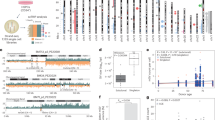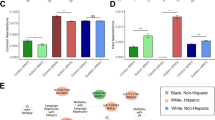Abstract
Neurofibromatosis type 1 (NF1) is an autosomal dominant nevus disease characterized by multiple manifestations, primarily café-au-lait macules and neurofibromas. Here, we present the case of an NF1 patient with 47,XYY mosaicism whose diagnosis was prompted by café-au-lait macules on the skin and mandibular neurofibromas. Targeted next-generation sequencing of the patient’s blood sample revealed a novel frameshift mutation in NF1 (NM_000267.3:c.6832dupA:p.Thr2278Asnfs*8) that is considered a pathogenic variant.
Similar content being viewed by others
Neurofibromatosis type 1 (NF1; OMIM 162200), an autosomal dominant nevus disease with multiple manifestations, mainly café-au-lait macules and neurofibromas, affects 1 in 3000 people, and approximately 50% of cases arise de novo1. The causative gene, NF1 (17q11.2; NM_001042492.3), was identified in 19902,3,4 and encodes the GTPase-activating protein (GAP) neurofibromin5. The diagnostic criteria for NF1 were outlined at the National Institutes of Health (NIH) Consensus Development Conference in 19886 and revised in 20217. Approximately 7% of NF1-related neurofibromas manifest in the oral cavity, and mandibular occurrence is rare8. The incidence of 47,XYY syndrome in live-born male infants is 1 in 10009, and the disorder is commonly diagnosed in the first decade of life based on developmental delays, behavioral issues, and tall stature10. Herein, we report a novel NF1 frameshift mutation in a patient with NF1 and 47,XXY/46,XY mosaicism whose NF1 diagnosis was prompted by mandibular neurofibromas.
At 7 years of age, the patient visited Tokyo Medical and Dental University Hospital’s oral surgery department following a radiolucent finding around a buried left mandibular first molar on radiographic examination. His medical history included epilepsy, intellectual disability, autism spectrum disorder, and a mosaic karyotype of 47,XYY (43.3%)/46,XY (56.7%), identified through chromosome karyotyping at age 1. The patient’s parents showed no abnormalities, and the family history was unremarkable. The left mandibular first molar had not erupted, and panoramic radiography revealed a radiolucent area around its crown (Fig. 1a). A biopsy confirmed the presence of neurofibroma around the left mandibular first molar. Skin examination revealed multiple café-au-lait macules throughout the body. Clinical diagnosis of NF1 was based on these macules and multiple neurofibromas observed in the left mandibular coronoid process, left mandibular ramus, left mandibular body (biopsy area), and adipose tissue of the left masticator space on computed tomography (CT) scans at age 9 (Fig. 1b–e). Jaw neurofibromas were managed through observation. However, given that the left mandibular first molar had not erupted, the tumor in that area was removed, and fenestration surgery was performed at 10 years of age. Magnetic resonance imaging (MRI) at 16 years of age revealed a right pontine hamartomatous lesion associated with NF1 (Fig. 2a), a 35 mm neurofibroma in the medial mandibular ramus (Fig. 2b), and suspected neurofibromas in the right buccal (Fig. 2c) and left mandibular subcutaneous (Fig. 2b) regions. MRI at age 22 showed lumbar subcutaneous adenomas (Fig. 2d) and neurofibromas around the bilateral psoas major muscle (Fig. 2e) and along the pleura (Fig. 2f). By age 29, axillary and inguinal freckling was confirmed, prompting genetic testing of a peripheral blood sample. This study was approved by the Ethics Review Committee of our institution (D2020-084), and written informed consent was obtained from the parents of the patient. Targeted next-generation sequencing of NF1, NF2, SPRED1, SMARCB1, and LZTR1 using the hybrid capture method at the Kazusa DNA Research Institute, Chiba, Japan, identified a heterozygous mutation, c.6832dupA (p.Thr2278Asnfs*8), in the NF1 gene (NM_000267.3). Sanger sequencing confirmed that the patient had the same mutation (Supplementary Information 1). This NF1 frameshift variant was not registered in ClinVar (https://www.ncbi.nlm.nih.gov/clinvar/), gnomAD (https://gnomad.broadinstitute.org/), ToMMo (https://jmorp.megabank.tohoku.ac.jp/), or HGMD (https://www.hgmd.cf.ac.uk/ac/index.php). The mutant was a null variant, absent from the gnomAD database, and assumed to be de novo, corresponding to PVS1, PM2, and PM6 in the American College of Medical Genetics and Genomics criteria, respectively; therefore, this variant was considered pathogenic11. With no notable changes in intramandibular or perimandibular lesions or systemic subcutaneous lesions, the patient remained under observation.
a Panoramic radiography at the initial examination (age 7). b–e CT imaging revealed multiple neurofibromas at age 9 in the left mandibular coronoid process (b), left mandibular ramus (c), left mandibular body (d), and adipose tissue of the left masticator space (e). Arrowheads indicate neurofibromas.
a Brain MRI axial FLAIR image at age 16. Arrows indicate hamartomatous lesions. b, c Coronal T2-weighted brain MR image at age 16. The arrows indicate nodules suspected to be neurofibromas in the left mandibular (b) and right buccal (c) subcutaneous areas. Arrowheads indicate neurofibromas. d Sagittal T2-weighted view of a lumbar MR image at age 22. The arrows indicate lumbar subcutaneous adenomas. e, f Axial T2-weighted views of a lumbar MR image at age 22. The arrows indicate neurofibromas around the bilateral psoas major muscle (e) and along the pleura (f).
Neurofibromatosis induces various abnormalities, particularly neurofibromas in the skin and nerves. In this patient, the NF1 diagnosis arose based on the presence of mandibular neurofibromas and café-au-lait macules on the skin. ~7% of neurofibromas in patients with NF1 are reported in the oral cavity8, with the palate, gingiva, tongue, buccal mucosa, and lips being common sites; however, mandibular occurrence is rare8. In the present case, despite the presence of café-au-lait macules as an NF1 clinical manifestation, the diagnosis was established only when mandibular neurofibromas were identified. Other developmental delays were noted, potentially attributed to the 47,XYY mosaic. Early recognition of comorbidities and comprehensive clinical assessments, facilitated by a timely diagnosis via a multidisciplinary approach, contribute to improving long-term health prognoses.
The diagnosis of 47,XYY is often based on behavioral and learning disabilities3. Despite its prevalence (1 in 1000 boys), ~85% of cases are undiagnosed until infertility arises due to atypical symptoms9, and limited information is available regarding the phenotype10. In our patient, chromosome karyotyping was performed at age 1 owing to developmental delays; however, the 43.3% mosaic nature of 47,XYY complicates our understanding of its impact on the patient’s clinical manifestations.
NF1, the first human condition attributed to pathogenic variants in RAS pathway genes, falls within the broader group of RASopathies, which includes Noonan, Costello, and cardiofaciocutaneous syndromes12. Legius syndrome (OMIM 611431), caused by a heterozygous pathogenic variant of SPRED1, is a RASopathy that exhibits the most overlap with NF113. Because other syndromes exhibit clinical manifestations similar to those of NF1, a simultaneous search for candidate pathogenic genes, including SPRED1, is useful for confirming genetic diagnoses. Although our case involved a relatively easy clinical diagnosis of NF1, simultaneous gene searches are crucial in patients with insufficient clinical manifestations for disease differentiation.
The variable phenotype of NF1, even in patients with identical genetic variants, poses challenges in predicting disease severity, including within families1,14. This variability may be attributed to factors such as genetic modifiers, epigenetic abnormalities, and environmental influences14. Clinical genetic testing, which has high detection rates and utility in identifying genotype–phenotype correlations5, has become crucial. In the present case, the identified frameshift mutation, with a stop codon behind the RAS-GAP domain, was revealed through next-generation sequencing.
Previous studies have aimed to identify genotype–phenotype correlations that can be used to predict disease progression. However, mutation hotspots are lacking, and knowledge of genotypes associated with specific phenotypes is limited15. Scala et al. reported that missense mutations were inversely associated with neurofibromas, whereas frameshift mutations and whole-gene deletions were associated with skeletal abnormalities16. Gjorgjievska et al. reported positive correlations between cognitive impairment and gross deletions or truncating variants17. Napolitano et al. reported increased odds ratios for learning disabilities in patients carrying frameshift mutations15.
Symptom appearance varies, with café-au-lait macules and neurofibromas potentially manifesting by age 1, whereas other symptoms may develop in childhood, requiring up to 20 years for a patient to meet all diagnostic criteria. Recent advancements in NF1 genetic testing have provided a clinically available approach with a high detection rate, enabling earlier diagnosis in suspected patients.
HGV database
The relevant data from this Data Report are hosted at the Human Genome Variation Database at https://doi.org/10.6084/m9.figshare.hgv.3400.
References
Dunning-Davies, B. M. & Parker, A. P. Annual review of children with neurofibromatosis type 1. Arch. Dis. Child. Educ. Pract. Ed. 101, 102–111 (2016).
Viskochil, D. et al. Deletions and a translocation interrupt a cloned gene at the neurofibromatosis type 1 locus. Cell 62, 187–192 (1990).
Cawthon, R. M. et al. A major segment of the neurofibromatosis type 1 gene: cDNA sequence, genomic structure, and point mutations. Cell 62, 193–201 (1990).
Wallace, M. R. et al. Type 1 neurofibromatosis gene: identification of a large transcript disrupted in three NF1 patients. Science 249, 181–186 (1990).
Koczkowska, M. et al. Clinical spectrum of individuals with pathogenic NF1 missense variants affecting p.Met1149, p.Arg1276, and p.Lys1423: genotype–phenotype study in neurofibromatosis type 1. Hum. Mutat. 41, 299–315 (2020).
Neurofibromatosis. Conference statement. National Institutes of Health Consensus Development Conference. Arch. Neurol. 45, 575–578 (1988).
Legius, E. et al. Revised diagnostic criteria for neurofibromatosis type 1 and Legius syndrome: an international consensus recommendation. Genet. Med. 23, 1506–1513 (2021).
Kunisada, Y., Yoshioka, N., Ibaragi, S., Okui, T., Nagatsuka, H. & Sasaki, A. A case of intramandibular neurofibroma resembling a radicular cyst in a neurofibromatosis type 1 patient. Int. J. Surg. Case Rep. 82, 105883 (2021).
Zou, C., Yu, D., Geng, H., Lan, X. & Sun, W. A patient with 47, XYY mosaic karyotype and congenital absence of bilateral vas deferens: a case report and literature review. BMC Urol. 22, 16 (2022).
Bardsley, M. Z. et al. 47,XYY syndrome: clinical phenotype and timing of ascertainment. J. Pediatr. 163, 1085–1094 (2013).
Richards, S. et al. Standards and guidelines for the interpretation of sequence variants: a joint consensus recommendation of the American College of Medical Genetics and Genomics and the Association for Molecular Pathology. Genet. Med. 17, 405–424 (2015).
Rauen, K. A. The RASopathies. Annu. Rev. Genom. Hum. Genet. 14, 355–369 (2013).
Brems, H. et al. Germline loss-of-function mutations in SPRED1 cause a neurofibromatosis 1-like phenotype. Nat. Genet. 39, 1120–1126 (2007).
Szudek, J., Joe, H. & Friedman, J. M. Analysis of intrafamilial phenotypic variation in neurofibromatosis 1 (NF1). Genet. Epidemiol. 23, 150–164 (2002).
Napolitano, F. et al. Genotype–phenotype correlations in neurofibromatosis type 1: identification of novel and recurrent NF1 gene variants and correlations with neurocognitive phenotype. Genes (Basel) 13, 1130 (2022).
Scala, M. et al. Genotype–phenotype correlations in neurofibromatosis Type 1: a Single-Center Cohort Study. Cancers (Basel) 13, 1879 (2021).
Gjorgjievska, M., Bozhinovski, G., Sukarova-Angelovska, E., Kocova, M., Kanzoska, L. M. & Plaseska-Karanfilska, D. Mutational spectrum and genotype–phenotype correlations in neurofibromatosis type 1 patients from north Macedonia: identification of ten novel NF1 pathogenic variants. Balk. Med. J. 40, 252–261 (2023).
Author information
Authors and Affiliations
Corresponding author
Ethics declarations
Competing interests
The authors declare no competing interests.
Additional information
Publisher’s note Springer Nature remains neutral with regard to jurisdictional claims in published maps and institutional affiliations.
Supplementary information
Rights and permissions
Open Access This article is licensed under a Creative Commons Attribution 4.0 International License, which permits use, sharing, adaptation, distribution and reproduction in any medium or format, as long as you give appropriate credit to the original author(s) and the source, provide a link to the Creative Commons licence, and indicate if changes were made. The images or other third party material in this article are included in the article’s Creative Commons licence, unless indicated otherwise in a credit line to the material. If material is not included in the article’s Creative Commons licence and your intended use is not permitted by statutory regulation or exceeds the permitted use, you will need to obtain permission directly from the copyright holder. To view a copy of this licence, visit http://creativecommons.org/licenses/by/4.0/.
About this article
Cite this article
Tonouchi, E., Morita, Ki., Harazono, Y. et al. NF1 with 47,XYY mosaicism diagnosed by mandibular neurofibromas. Hum Genome Var 11, 22 (2024). https://doi.org/10.1038/s41439-024-00279-8
Received:
Revised:
Accepted:
Published:
DOI: https://doi.org/10.1038/s41439-024-00279-8





